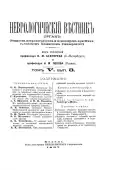Differential diagnosis of multiple neuritis. Polyesthesia and macroesthesia
- Authors: Shcherbak A.E.1, Ivanov I.I.1
-
Affiliations:
- Clinic of Nervous and Mental Diseases of Warsaw University
- Issue: Vol V, No 3 (1897)
- Pages: 79-102
- Section: Original article
- URL: https://journals.rcsi.science/1027-4898/article/view/46717
- DOI: https://doi.org/10.17816/nb46717
- ID: 46717
Cite item
Full Text
Abstract
The involvement of the spinal cord in infectious polyneuritis can be primary or secondary.
With regard to primary participation, here again two clinical forms must be distinguished:
1) Toxins have only a short-term and weak effect on the spinal cord, which is expressed, usually at the beginning of the disease, by transient disorders of the functions of the bladder and rectum, at which, however, the usual clinical picture and the course of polyneuritis do not represent significant changes; prediction does not get worse (compare the cases of Oppenheim’a, Kanonnikov, Charcot, Rhode, etc.)
2) In the second category of cases, the toxins act more vigorously on the blood vessels and the most nervous elements of the spinal cord, causing persistent organic damage to it, and how new, unusual for polyneuritis, features are introduced into the clinical picture, so the course of the disease changes; prediction gets worse.
Keywords
Full Text
##article.viewOnOriginalSite##About the authors
A. E. Shcherbak
Clinic of Nervous and Mental Diseases of Warsaw University
Author for correspondence.
Email: info@eco-vector.com
Prof.
Russian Federation, WarsawI. I. Ivanov
Clinic of Nervous and Mental Diseases of Warsaw University
Email: info@eco-vector.com
Doctor
Russian Federation, WarsawReferences
Supplementary files






